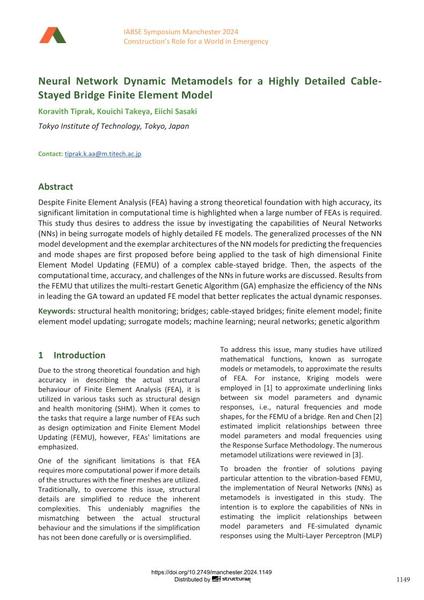Neural Network Dynamic Metamodels for a Highly Detailed Cable-Stayed Bridge Finite Element Model

|
|
|||||||||||
Bibliografische Angaben
| Autor(en): |
Koravith Tiprak
(Tokyo Institute of Technology, Tokyo, Japan)
Kouichi Takeya (Tokyo Institute of Technology, Tokyo, Japan) Eiichi Sasaki (Tokyo Institute of Technology, Tokyo, Japan) |
||||
|---|---|---|---|---|---|
| Medium: | Tagungsbeitrag | ||||
| Sprache(n): | Englisch | ||||
| Tagung: | IABSE Symposium: Construction’s Role for a World in Emergency, Manchester, United Kingdom, 10-14 April 2024 | ||||
| Veröffentlicht in: | IABSE Symposium Manchester 2024 | ||||
|
|||||
| Seite(n): | 1149-1157 | ||||
| Anzahl der Seiten (im PDF): | 9 | ||||
| DOI: | 10.2749/manchester.2024.1149 | ||||
| Abstrakt: |
Despite Finite Element Analysis (FEA) having a strong theoretical foundation with high accuracy, its significant limitation in computational time is highlighted when a large number of FEAs is required. This study thus desires to address the issue by investigating the capabilities of Neural Networks (NNs) in being surrogate models of highly detailed FE models. The generalized processes of the NN model development and the exemplar architectures of the NN models for predicting the frequencies and mode shapes are first proposed before being applied to the task of high dimensional Finite Element Model Updating (FEMU) of a complex cable-stayed bridge. Then, the aspects of the computational time, accuracy, and challenges of the NNs in future works are discussed. Results from the FEMU that utilizes the multi-restart Genetic Algorithm (GA) emphasize the efficiency of the NNs in leading the GA toward an updated FE model that better replicates the actual dynamic responses. |
||||
| Stichwörter: |
Brücken Schrägseilbrücken Finite-Elemente-Modell
|
||||

